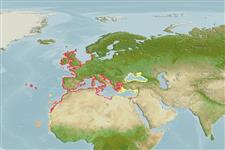Common names from other countries
Environment: milieu / climate zone / depth range / distribution range
экология
морской; пресноводный; солоноватоводный демерсальный; амфидромный (Ref. 46888); пределы глубины 0 - 15 m (Ref. 45332). Subtropical; 8°C - 24°C (Ref. 4944); 60°N - 12°N, 32°W - 42°E
Eastern Atlantic: western Scotland to Senegal. Also known from the Mediterranean and Black Sea. Indian Ocean: as lessepsian migrant in the Gulf of Eilat and Red Sea (Ref. 5299). Records from Pointe Noire and vicinity might be doubtful.
Length at first maturity / Size / Вес / Возраст
Maturity: Lm 6.5, range 6 - 7 cm
Max length : 13.0 cm TL самец/пол неопределен; (Ref. 49698); наибольший возраст (опубликованны данные): 10 годы (Ref. 35388)
Neck naked. No black spots in the front end of each dorsal fin (Ref. 35388).
Predominantly marine, but may enter freshwater. Adults occur inshore in intertidal waters, under stones and in pools on sheltered rocky shores with much weed cover. Macrobenthos feeder on hard substrates (Ref. 92840), they feed on crustaceans (larger amphipods, isopods, small crabs) and polychaetes; juveniles eat harpacticoid copepods, amphipods, polychaetes and mites (Ref. 4696). Oviparous (Ref. 205). Fusiform shaped eggs are found in patches of several thousand on undersurface of stones, shells, polychaete tubes or Ciona mantles (Ref. 4696).
Oviparous (Ref. 205). Male guards the eggs deposited by the female under rocks or inside empty bivalve shells until they hatch (Ref. 45332). Larvae remain near the substrate until they assume the cryptobenthic behavior of the adults (Ref. 45332). Are repeat spawners (Ref. 4696).
Maugé, L.A., 1986. Gobiidae. p. 358-388. In J. Daget, J.-P. Gosse and D.F.E. Thys van den Audenaerde (eds.) Check-list of the freshwater fishes of Africa (CLOFFA). ISNB, Brussels; MRAC, Tervuren; and ORSTOM, Paris. Vol. 2. (Ref. 4343)
Статус Красного Списка МСОП (Ref. 130435)
CITES (Ref. 128078)
Not Evaluated
Угроза для людей
Harmless
Использование человеком
рыболовство: не имеет хозяйственного значения; аквариум: общественные аквариумы
дополнительная информация
инструменты
Специальные отчеты
Скачать в формате XML
ресурсы в Интернет
Estimates based on models
Preferred temperature (Ref.
115969): 9.8 - 20.2, mean 17.7 (based on 823 cells).
Phylogenetic diversity index (Ref.
82804): PD
50 = 0.5000 [Uniqueness, from 0.5 = low to 2.0 = high].
Bayesian length-weight: a=0.00871 (0.00672 - 0.01128), b=3.10 (3.06 - 3.14), in cm Total Length, based on LWR estimates for this species (Ref.
93245).
Trophic level (Ref.
69278): 3.3 ±0.45 se; based on food items.
устойчивость к внешним воздействиям (Ref.
120179): средний (среднего размера), минимальное время удвоения популяции 1.4-4.4 года (K=0.41; tm=0-3; tmax=10; Fec=1,054).
Fishing Vulnerability (Ref.
59153): Low vulnerability (19 of 100).
